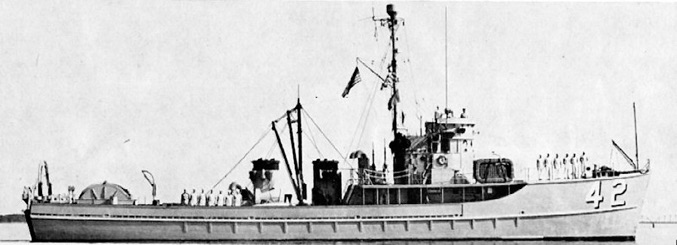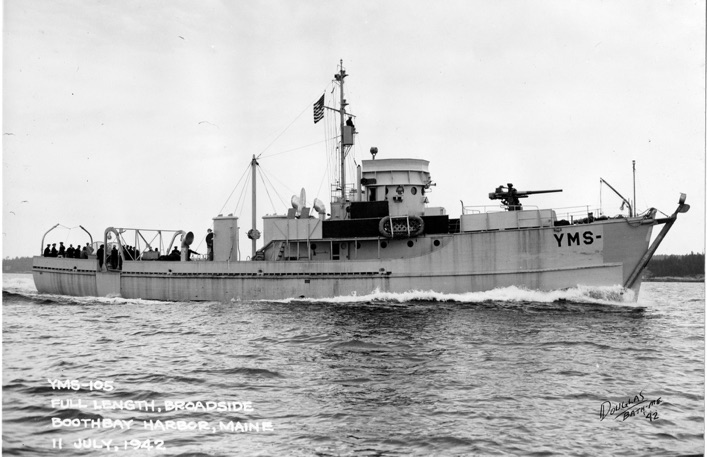YMS-105
Gypsy Queen

YMS-105
Gypsy Queen


YMS 105
The first “Yard class Minesweeper (YMS)” was built in the Henry B. Nevins Inc. Shipyard, in City Island, New York. The keel of the YMS-1 was laid March 4, 1941 and she was launched on January 10, 1942, but completely finished two months later on March 25, 1942.
A total of 561 minesweepers were built for the war with 481 serving the US Navy and 80 serving the British (BYMS).
The 481 minesweepers serving the US Navy had generally the same characteristics, with the only variation being one of appearance. YMS-1 through 134 had two stacks, 135 through 445 along with 480 and 481 had one stack, while YMS-446 through 479 had no stack.
Originally rated as service craft, the minesweepers were used during WWII for inshore sweeping to prepare the way for amphibious assaults.

It is true nothing happened by the way of naval action without the aid of the minesweeper. Without them no sea bound invasion could have taken place until the path had been cleared of all mines. The minesweeper also had the hazardous task of removing these unseen killers. With this, the minesweeper crew had a motto, “…wherever the fleet goes, we’ve been!”
The YMS-class minesweeper not only enjoyed the greatest number of units built to a common design, but managed to serve every Allied Navy from 1942 well into the late 1970’s. Nearly a quarter of all ship losses in WWII were caused by mines, thus reinforcing the minesweepers importance. Every minesweeper crewman endured extraordinary dangers making navigable waters safe, and although little recalled today, the minesweeper’s role in naval warfare was the reason so many YMS class had to be built and deployed from the Aleutians to Cape Horn.
The YMS 105 was laid down on May 13, 1941 by Frank L Sample Jr. Inc., at Boothbay Harbor, Maine. On March 10th, 1942 she was launched into the frigid waters, and 4 months later on July 17th, the 105 was completed. The length of the 105 is; 136 feet, beam 25 feet 7.5 inches, draft 8 foot 6 inches, and it displaced 245 tons. With its two 880 BHP (Brake Horsepower) General Motors diesel engines (2 shafts) they could reach speeds up to 15 knots. The armament consisted of one 3” .50 caliber anti-aircraft gun, four .50 caliber machine guns, two 20 mm guns, and two depth charge projectors. The 105 stocked eight 300 Lb. depth charges.
On August 3rd, 1942, the 105 completed its fitting in Boston and was to be delivered to the Commander in Chief, Admiral Ernest Joseph King U.S. Fleet, and reported for duty at the Eastern Sea Frontier. Commander of the ESF was Vice-Admiral Adolphus Andrews, and it was he who would make the arrangements for the training shakedown and preparations for trials to take place on August 25th. The YMS 105 completed the trials, without flaw on September 1st.
A United States Navy operational command, The Eastern Sea Frontier consisted of the patrol of coastal waters from Canada to Jacksonville, Florida during WWII. This wide patrol extended out at a distance from the shoreline, approximately 200 miles. Vice-Admiral Adolphus Andrews, whose operational orders could only be appealed to Admiral Ernest King, had total control and the esteemed responsibility for convoys within the defined coastal area. The task of this patrol, in addition to providing much needed escort for convoys, was to provide sea-air rescue, harbor defense, shipping lane patrol, and in the case of the yard minesweeper, sweeping for live mines.
It is very important to note that from 1942 to 1944 the YMS 105 was a part of the Eastern Sea Frontier, a tactical operation that was considered by some the “parent” of all frontiers in WWII.
On January 30, 1945 the YMS 105 arrived in New York and there she sat for temporary duty.
Her duty orders were amended, and on August 1st, 1945, she reported to CinCPac (Commander in Chief Pacific) in California and was prepared for operations in the Pacific. The United States area of jurisdiction, for Pacific Operations, covered over 50% of the world’s surface area (approx. 105 million square miles). This included 36 countries, 20 territories, 10 territories and possessions of the U.S., and nearly 60% of the world’s population.
Since the war had basically ended in September of 1945, the YMS 105 reported then to ComNavBase (Commander Naval Base) in San Francisco in February 1946 where she was used very little. The Gallant YMS 105 was decommissioned shortly thereafter on April 17th, 1946 and stripped.
On May 1st, 1946, she was struck from the Naval Register, and then transferred to the U.S. Marine Corps. where it was accepted and simultaneously delivered on September 25, 1947 to the U.S. Naval Magazine, Port Chicago, California to Hanly V. Knaflich. After that it was delivered to the Mare Island Shipyard in Vallejo, California, where it was most likely cleaned up and readied for sale to the civilian market.
The 105’s official number is 289689 and rumors have it she exchanged ownership 13 times since her service in WWII. Before she was given her name of the Gypsy Queen, the YMS 105 was also known as the Emerson.
In 1958, Thomas Stanley Hill and his wife Alice purchased the Emerson in Washington State, re-named it the Gypsy Queen, and registered it on January 29th, 1963 with the US Coast Guard in Juneau Alaska.

Thomas Stanley Hill, or known to most as Stan, had great plans for the Gypsy Fleet. Along with the Queen he also acquired a 60 foot trawler, built in 1930, and named it the Gypsy Trader. Stan’s plans didn't stop there. He then bought a small tug and named it the Gypsy Too.
The idea, that would be part of his retirement in Alaska, was to use the Queen as a fish-processing plant, the Trader as a pickup boat, and since the Queens engines had burned out 15 years prior, the Gypsy Too would tow her to Alaska. The plans were made and the boats were purchased and ready. Then disaster struck.
In 1965, the tug Gypsy Too caught fire, burned and was a total loss. Keeping the Trader close at hand, and tied to the Queen, HIlls dreams were not yet crushed.
In April of 1968, bad luck struck again to Stan and Alice, when the Trader sprung a leak and sank in 40 feet of water while the Hills were sleeping.
Despite the painful events, Stan continued with his plans and fit the Gypsy Queen with refrigeration equipment and generators. Stan was determined to make the one final voyage with the Queen.
It is not known (yet) when the Queen sank in Lake Union but now it sits in 40 feet of water at the south end of Lake Union, sitting upright, as it would have been in her mooring, as if ready for someone to take her on her final voyage, not knowing that that final trip has come and gone.

Video Courtesy Chris Borgen on a stellar visibility day
VIDEO LOADED 1/30/11
BY DAN WARTER
VIDEO LOADED 11/21/10

Courtesy Dick Wagner/CWB


-Home